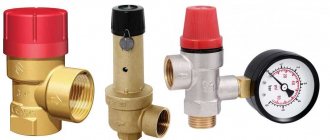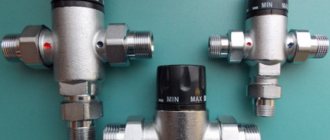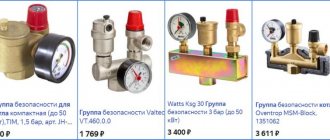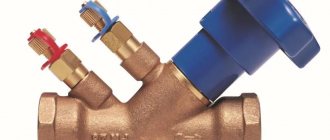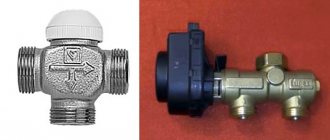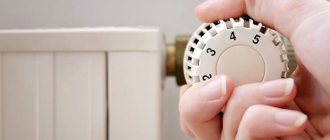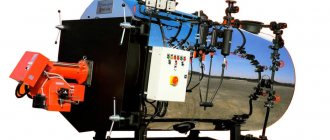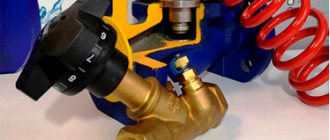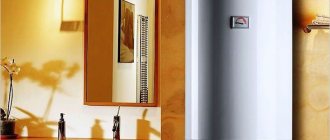Here you will learn:
- Where is it installed in the heating system?
- Operating principle of a check valve
- Types of check valve
- Direct and indirect acting valve
- Check valve connection diagrams
- Installation recommendations
One of the mandatory elements of any system is a check valve for heating, which is used in the circuit to regulate the direction of circulation of the coolant. Buyers have access to various models on the market, which differ in method of use and design features. Although most ordinary people have a general understanding of the purpose of a valve in a heating system, this type of fittings performs important functions and helps prevent serious accidents caused by changes in water flow due to pressure surges or airy batteries
.
What is it and what is it for?
A check valve is one of the elements of protective pipeline fittings.
The main purpose is to prevent changes in the direction of water flow. It automatically closes the pipeline if the flow direction changes in the opposite direction.
Water check valve
Also performs the following functions
- When the water supply is turned off, it prevents its outflow through the riser
- Blocks hot water from entering the cold water supply system and vice versa
- Significantly reduces the likelihood of water hammer
- Increases the operating time of equipment (pumps, meters, etc.)
- Reduces the risk of broken connections in the plumbing system
Where is it used?
A non-return valve is very useful in the water supply of a private home.
If for some reason the pump stops, it prevents water from flowing back into the well or borehole. In the event of a power outage or pump shutdown, there is no need to refill the system with water.
On water pipes.
The supply of hot and cold water in private and apartment buildings is carried out through different pipes. Sometimes different water pressure causes hot water to fill cold water pipes. The valve allows you to bring the pressure back to normal.
In front of the cold and hot water meter.
Helps protect against damage in the event of a water hammer.
At the inlet to the water heater.
The boiler is filled under pressure. When warming up and pressure increases, the displaced coolant will be directed back into the cold pipe. Prevents churn
Operating principle of a check valve
- The flow of water flowing through the pipes under pressure acts on the shut-off element and presses out the spring, which keeps the valve closed.
- After the spring has compressed, the valve opens and water flows freely through it in the desired direction.
- When the pressure in the water supply drops or when water moves in the opposite direction, the spring mechanism of the device moves the valve to the closed state.
- All the actions of the shut-off valve prevent the formation of backflow in the water supply system.
Operating principle of a check valve
Miscellaneous
Tank
A rectangle with a long side horizontally is a symbol of a tank. The open top symbol indicates a vented tank. The closed top symbol indicates a sealed tank.
Battery
The accumulator is oval in shape and may have additional parts to indicate spring pressure or gas charge.
Oil cooler
The oil cooler is shown as a square, rotated 45° and has connections at the corners.
Filter/Strainer
Dotted line inside a rotated square
Design Features
Housing material
The most common material used to make a check valve body is brass. This material is highly resistant to chemicals that may be present in water (mineral salts, oxygen, iron compounds, manganese, sulfur and others).
titanium, cast iron, steel, bronze mainly used in industrial systems
Plastic is used in polypropylene pipelines with water temperatures up to 90 degrees
Rubber or silicone sealing gasket.
Check valve device
Shutter element
It comes in the shape of a ball, cone, or “plate”. Double-leaf check valves are also used in pumping stations and water supply systems. They have a shutter in the shape of two semicircular fragments. Most often made of brass
Return mechanism.
To return the shutter to the closed state, the device has a spring. Stainless steel is most often used to make the spring (an important element of the shutter). But there are also models where, under pressure, the shutter rotates on hinges.
Nuances of proper installation
During the installation of shut-off valves, several rules should be strictly followed:
- The valve is installed strictly in the direction of coolant flow. To avoid mistakes, the product body must be marked with an arrow indicating the working direction.
- Paronite gaskets can be used to seal connections, provided that they do not reduce the diameter of the passage hole. Otherwise, the valve will exert more hydraulic pressure than intended.
- The device must be installed so that other elements of the heating system do not exert additional pressure on its body.
- It is highly advisable to install a mesh in front of the check valve for rough cleaning. This will make it possible to prevent solid particles from entering the locking mechanism, which, in turn, can lead to a violation of the tightness of the device when closed. Or use special valves with mesh.
Another important point: before installation, you need to once again make sure that the valve is selected correctly.
For example, for schemes with forced circulation, any type of device is suitable, but for gravitational systems, only a rotary petal device without a spring. Since the coolant moving by gravity will not be able to cope with the resistance of the spring.
Types of check valve
Spring (lifting)
Its design is similar to a shut-off valve. With sufficient pressure, the valve rises up, opens the hole, allowing the flow to circulate. At low pressure it falls down onto the seat and the water path is blocked. All this happens automatically.
It is used only on horizontal pipes, with mandatory vertical axial installation.
Advantages of a spring valve. Repair is possible without dismantling, as it has a removable cover. Plus it can be used at high temperatures.
High tightness. Versatility, can be used in both private and industrial water supply systems.
One of the disadvantages of spring valves is sensitivity to dirt and mineral impurities contained in water, which can damage them. But this can be solved by installing a filter.
Ball valve
The locking element in this device is a metal ball. Sometimes the ball is covered with rubber for reliability.
If there is no pressure in the water supply, the ball, under its own weight, tightly blocks the passage hole and prevents the liquid from moving in the opposite direction. When water is supplied, the resulting pressure lifts the ball, opening the way for the water flow.
Ball check valve
Pros. Ball check valves can be installed in vertical and horizontal pipes
Simple design and absence of mechanical components increases service life.
However, it should be remembered that with an equal internal cross-section, the outer dimensions of a ball valve are larger than that of other types of valves.
Rotary or paddle
The valve received this name because of its design.
It is based on a metal disk (“plate”) and an axis with a spring. The axis of rotation is located above the through hole. When open, the disc is parallel to the movement of water; when closed, it is perpendicular. Under fluid pressure, the disc opens. When the pressure drops, the spring is activated, the disk turns and blocks the flow. rotates under fluid pressure. If the pressure drops, the spring is activated and the disk blocks the path of water
The disadvantage is that in valves of large diameter there is a strong impact when slamming, which can lead to rapid failure of the structure.
Rotary check valves are divided into two groups:
Simple - with a small diameter of up to 400 mm. Used in systems where shocks cannot greatly affect the operation of the hydraulic system and the valve itself
Impactless - valves with a special mechanism that ensures smooth closing of the disc. The downside is that they are more expensive.
Double check valve
This device has two locking segments, which are located on a rotating axis. The plates are located in the center of the passage hole.
Water moving in the right direction opens the doors. If the direction of flow changes, the plates, under the action of springs, close the passage of the liquid.
Butterfly valves come in a wide range of sizes so they can be installed on pipes of various diameters.
They are also recommended for installation in systems where high pressure is present.
Adjusting the water pressure in the apartment
The water regulator in the apartment performs several important tasks at once. The first is protection against high blood pressure. Most household plumbing fixtures are designed for up to 3 atm.
If it is larger, then the apartment’s water supply system is under increased load. The consequence of this is a reduction in the service life of the valves of washing machines and dishwashers, a decrease in the reliability of connections and other unpleasant phenomena.
A pressure regulator is a small device that is used to combat water hammer. It can also be used to control and, if necessary, adjust the water pressure in a particular system.
The use of this device allows you to optimize the operation and increase the service life of utility lines. Often, a pressure reducer is used at the following facilities:
And finally, the most interesting function for us is saving water in the apartment. The ability to regulate pressure opens up wide possibilities for reducing its consumption. A simple reduction in pressure from 6 to 3 atm will reduce water consumption by 20-25% (in a family of 4 people). After all, every time you open the tap fully, you will spend less than before.
And you can go even further. If you do not have devices in your apartment that require a certain minimum pressure (a reverse osmosis system or instantaneous water heater, for example), then you can reduce the pressure down to 1-2 bar. The savings will be even greater, and discomfort will only be caused by a longer filling of the toilet tank.
The benefits of the reducer will be most appreciated by those whose pressure in the cold and hot water risers constantly “jumps”. Because of this, you have to adjust the pressure with the mixer for a long time each time, in search of the optimal temperature.
Often, such adjustments take more time than the shower itself, and precious cubic meters of water wastelessly go down the drain. With the help of gearboxes you can balance the pressure in the pipes and forget about this problem.
Working principle of the water pressure regulator
In most regulators, the reduction mechanism is based on a sealed chamber in which there is a membrane with a spring rod attached to it. As water is supplied, the output pressure of the reducer decreases - this leads to a decrease in the impact on the diaphragm.
In turn, a specially adjusted spring exerts great pressure on the diaphragm, thereby equalizing its value to that installed on the gearbox.
Typically, the installation of the regulator is carried out first when installing a water main in a house or apartment. If a water pressure reduction reducer is not installed at the inlet, then install a reducer for a boiler, washing machine/dishwasher or gas boiler!
- Based on their operating principle, water pressure reducers are divided into:
- dynamic, providing continuous regulation of a constant flow of water and used mainly in main pipelines and industrial facilities;
- static, operating under conditions of uneven water consumption, usually installed at the entrances to apartments or private houses.
- According to the place of adjustment, they are divided into gearboxes that operate:
- “to itself”, closed in the absence and opening when the water pressure at the regulator input increases, limiting its maximum level;
- “after itself”, in the absence of pressure, open and closed when the maximum level of water pressure at the outlet of the regulator is exceeded.
Static regulators always maintain constant pressure at the outlet, i.e. “after itself”.
Device structure
- At the heart of the regulator is a mechanical pressure sensor, which is used to control the mechanism that limits the water supply. For apartments and country houses, piston and valve gearboxes are used. As for throughput, here the devices are divided into the following products:
- household;
- commercial;
- industrial.
- In addition, water pressure regulators are classified according to other parameters, such as:
- Case material. For the manufacture of the device, brass, nickel-plated or chrome-plated steel is used.
- Working temperature. So, models that operate up to 40 degrees are installed on a cold water supply system. For hot water, reducers with operating temperatures from 65 to 90 degrees are used. It is prohibited to use “cold” regulators on a hot water supply, as this will lead to their rapid wear.
- Mounting method. Pressure reducers can be mounted by threaded connections or using fittings.
- Diameter and thread.
All these features must be taken into account when choosing a water pressure reducer in the water supply. This will allow you to purchase a suitable option for a particular circuit.
According to their design, gearboxes are divided into three main types:
Piston water pressure reducers. The simplest in design and the cheapest, and, consequently, the most common. They contain a spring-loaded piston that blocks the cross-section of the pipeline, thereby regulating the outlet pressure. The usual adjustment range is from 1 to 5 atm.
The disadvantage of such regulators is the presence of a moving piston, which determines the requirements for pre-filtration of water at the inlet of the gearbox, as well as limiting the maximum flow rate, which leads to increased wear of moving parts.
Diaphragm water pressure reducers. They provide regulation using a spring-loaded diaphragm installed in a separate sealed chamber that opens and closes the control valve.
Such gearboxes are distinguished by high reliability and unpretentiousness, a large range and proportionality of pressure regulation, as well as a wide spread of operating flow rates, ranging from 0.5 to 3 cubic meters. m./h. They also differ in higher cost.
Flow-through water pressure reducers. They provide dynamic pressure regulation due to the internal labyrinth located in the housing and reduces the flow speed by dividing it and numerous turns. They are mainly used for watering and irrigation systems.
Due to the absence of moving parts and the use of plastic materials for their manufacture, they are low in price, however, they require the installation of an additional regulator or valve at the inlet. Operating range - from 0.5 to 3 atm.
- The main characteristics of the gearbox are:
- The nominal diameter, which must correspond to the nominal diameter of the pipeline system. This parameter is regulated by GOST 28338–89.
- The highest maximum pressure at which long-term operation is guaranteed. This parameter must comply with GOST 26349–84.
- Throughput, cubic meters m/h, at which the established adjustment limits are ensured.
- Range of adjustable pressures of the reducer.
- The operating temperature range of the device, which determines its ability to function in heating and hot water supply systems, as well as in low temperature conditions.
Installing a water pressure reducer
In relation to the principle of operation, pressure reducers are divided into static and dynamic. The first option involves installing them in places with uneven water intake. The second version of the gearbox is relevant for constantly maintaining a certain pressure in the system.
- Among the advantages of installing a gearbox in an apartment, we note:
- protection of the water supply network from water hammer;
- increasing the service life of water equipment;
- reduction of water consumption;
- minimal noise during water flow;
- the presence of constant water pressure in the system.
- In relation to the main element of pressure regulation, reducers are diaphragm or piston. We invite you to familiarize yourself with the advantages of membrane compensators:
- high level of reliability and performance;
- excellent corrosion protection;
- the membrane divides the body part into two halves, one of which is in contact with water, and the second is separated from it;
- there is no need for additional maintenance.
However, during the operation of membrane pressure reducers, sometimes membrane delaminations, cracks and ruptures appear, which damage the equipment. Therefore, the membrane needs periodic monitoring of its condition.
We recommend installing a Tomasetto gearbox, which has good performance characteristics and high quality. The reducer has a solenoid valve and a built-in filtration system.
Therefore, during its installation there is no need to install filters. Reducers are able to maintain optimal pressure in the system.
How to install a water pressure reducer with your own hands
The process of installing a water reducer is quite simple, provided you have certain plumbing equipment and the skills to work with it. It is recommended to install the gearbox horizontally, this will ensure its high performance.
If there are no shut-off valves in the system, install them before starting work. In the process of work, you will need the gearbox itself, two or three shut-off valves, filters that purify the water, an adjustable wrench, tow and a composition that ensures its gluing.
- The gearbox installation process involves performing the following actions:
- First turn off the water.
- Cut a piece of pipe that is the same size as the two valves and the pressure regulator.
- Place the thread on the hole. If the pipes are made of plastic, then it is enough to solder them.
- Tow is wound onto the surface of a soldered or cut pipe and fixed to it using a special adhesive composition. Install the valve by turning it clockwise several times. Do not use too much force to complete this process as you may damage the faucet.
- To seal existing joints, use rubber gaskets or tow with glue.
- The gearbox is installed after installing the meter. Between them there should be valves and filters that carry out rough cleaning. All elements must be in the correct order.
- Further, after installing the pressure regulator, a second valve is installed, with the help of which the equipment can be easily dismantled, if necessary.
At this point, the installation of the gearbox is completed, however, in order for the device to work correctly, care must be taken to configure it correctly. Initially, close the valve at the entrance to the system and open the outlet valve.
Turn the screw to adjust the device clockwise using a special wrench. Thus, the pressure in the system will increase. To decrease, turn in the opposite direction. The pressure value should not exceed three atmospheres.
Please note that the diameter of the device must be the same as the size of the pipes in the house. If you purchased a gearbox that does not match the diameter of the pipes, the situation can be corrected by purchasing special adapters. In addition, when buying a reducer, do not forget about two valves and a filter.
How to adjust the water pressure reducer
To correctly configure the water pressure reducer, you need to decide on the reducer model. Most gearboxes are set at the factory, i.e. Gearboxes have a preset value. Manufacturers of relatively inexpensive gearbox models, for example the Italians, often do this.
The standard set water pressure is 3.0 bar (about 3.0 atmospheres). Usually this value is quite enough for a city apartment or a country house, but it is often either too high, for example for a boiler, or too low, for example if it is installed in a private house with several floors.
In this case, you can always change the water pressure.
Inexpensive models use either a wrench or a screwdriver for adjustment, but keep in mind that you will need a pressure gauge with scale readings higher than you plan to set. We recommend setting pressure gauges to 10.0 bar. The adjustment is made when the reducer is already installed, a pressure gauge is connected to it and there is already water in the pipeline.
Smoothly, using a screwdriver or wrench, turn the central rod of the gearbox clockwise (if you reduce the pressure) or counterclockwise (if you increase it). Observe the pressure gauge readings. Usually 2 - 3 turns are enough to change the range by 1-1.5 bar.
In more expensive models, you can do without a special tool. The manufacturer has already taken care of your convenience. The adjustment knob is already installed on the central rod and it is enough to turn it clockwise or counterclockwise a few turns and you will immediately see the result.
Some manufacturers include a pressure gauge and an additional “dirt filter” in the kit to protect the internal structure of the gearbox from mechanical particles.
Water pressure regulator repair
The purpose of the reducer is to maintain the specified outlet pressure as accurately as possible, regardless of changes in the inlet and consumed water flow. This is necessary so that consumers do not feel discomfort at different degrees of water intake, and at each water intake point, using fittings, it would be possible to independently regulate water flow within a wide range.
It is also important that the reducer maintains the set pressure even in the absence of water intake (in static mode), as this ensures trouble-free operation of residential pipelines, fittings and devices.
- Maintenance:
- Once a month, it is recommended to check the settings, response speed and accuracy of pressure maintenance by the regulator. They check the operation of the regulator by changing the flow rate of water passing through it - smoothly closing the fittings installed on the same pipeline.
- The pulse selection line should be cleaned every six months. To do this, the area on which the regulator is installed should be disconnected, drained, and the impulse line should be purged, having previously been disconnected from the regulator and the pipeline.
- The mesh filter installed in front of the regulator is cleaned as it becomes dirty. The clogging of the filter is determined by the readings of the pressure gauges provided before and after it, comparing the actual pressure drop across the filter with the drop across a clean filter.
Repair of the regulator may be required if, during operation or maintenance, a deviation of the pressure at the point where the pulse is taken from the set value is detected. Repairing the gearbox yourself is impractical; it’s easier to replace it with a new one, but you can try simple operations.
Possible breakdowns and ways to eliminate them:
| Breaking | Cause | Elimination |
| The regulator does not respond to changes in pressure at the connection point | Impulse line clogged | Blow with compressed air or water pressure, having first disconnected from the regulator |
| — | A foreign object has entered the flow part | Clean the valve and seat after removing the regulator |
| — | The rod is stuck | Clean the rod from scale and work it manually, having previously dismantled the regulator and hydraulic drive |
| The regulator is always closed | There is no spring or adjusting nut through which the spring holds the rod in the open position | No comments |
| The regulator is always open | Water pressure in front of the regulator, below the setting pressure | Change the setting pressure using the adjusting screw or wait for the pressure to increase |
| — | Membrane ruptured | Replacement with original membrane required |
- The most common questions on repair forums:
- The water pressure reducer is leaking, what should I do?
- how to clean the gearbox?
If it leaks, you can sort it out, but it’s better to throw it in the trash. It’s an inexpensive device, but its reliability determines whether you will heat it or not)
Classification by installation method
Flanged valve
With this type of device, the return flange and the supply flange are welded to the valve body and a single structure is obtained.
This type of valve is mainly used in industrial systems for large diameter pipes.
Due to its large size, it can cause water hammer, since at the moment of closing, increased pressure is created in the system. To avoid this, systems use shock-free shutters with soft closing.
Advantages: ability to work in systems with water pollution. Application on main pipelines with large pipe diameters.
Wafer
These devices have virtually no mounting hardware. The valve itself is mounted between two flanges, at the ends of the connected pipes. A special seal is placed at the installation sites. After this, the flanges are tightened together with threaded connections (bolts or studs).
If installed correctly, the valve will be securely fixed. In terms of reliability, this type of connection is almost as good as a flange connection.
Coupled
The most common in household plumbing.
With this connection, the valve is connected to the pipe using a threaded coupling.
Pros: No need to use additional fasteners. Not suitable for large diameter pipes.
Line (stream) symbols
Working, pilot and drain lines
A hydraulic hose, pipe, or other conduit that moves oil between components of a hydraulic system is indicated by a single line.
The working line (suction, discharge and return) is indicated by a solid line.
The pilot line is indicated by a dotted line with long dashes
The drainage line is indicated by a dotted line with short dashes
Connection/Transition Lines
To show that two intersecting lines are not connected, we use a short loop on one of the lines at the intersection.
The connection between two intersecting lines should be indicated by a dot at the junction.
Do I need a check valve for a water meter?
If you turn on several taps at the same time in an apartment building, pressure drops will occur in the water supply system. To avoid this, it is enough to install a check valve on the water meter, which will equalize the pressure drops.
The internal space of the meter must be constantly filled with water. This requirement allows the hydraulic check valve to be fulfilled. This will allow the meter to not fail for a long time.
If the pressure in the cold water pipe is greater than in the hot one. The meter will also start counting cold water. This will result in an increase in your utility bill accordingly. The check valve prevents cold water from entering the hot water system.
Valves that reliably block the water flow and prevent movement in the opposite direction. They will help prevent the consequences of water hammer for the water meter. This significantly increases the service life of the device.
Direct and indirect acting valve
Pressure control valves are divided into direct and indirect acting devices.
- The first type of valve has a simple design: a spring is driven by a shutter, which is directly pressed by the coolant. Such devices are inexpensive, easy to operate, reliable, insensitive to dirt, but not very accurate in settings.
- Indirect-acting devices, also called pulse devices, have a piston-actuated main valve, a smaller pulse valve, and a pressure transducer. When the pressure changes, the small valve presses on the piston, which moves the main valve, which regulates the throughput of the device. Thus, flow control occurs indirectly, in an indirect way. Valves of this type are less reliable due to the larger number of parts and are expensive, but they can be adjusted more accurately.
Where to install
- If necessary, a check valve is installed where it is necessary to ensure flow movement in one direction.
- After the water meter, to protect against water hammer
- On hot and cold water pipes when used simultaneously. Due to the pressure difference, overflow through the mixer is possible
- At the water heater inlet to prevent heated water from escaping into the cold water supply system
- In front of the pump or pumping station to prevent the outflow of water in the event of a power outage or breakdown
- At the very inlet of the suction pipe
- In the anti-drip protection system of the dishwasher and washing machine
Where in the apartment should I install a check valve - video
How to install correctly
The easiest way to install a check valve is through a threaded coupling. Suitable for installation in the water supply system of an apartment or private house.
Work order (step by step instructions)
Select location, see above
Prepare fittings of the required diameter.
Wrap a sealant around the thread (linen, fum tape, thread)
Use a fitting to secure the check valve
Open the tap and check for leaks
If you are unsure or doubt your capabilities, call a plumber
It is important! There is an arrow on the valve body. The direction of the arrow must coincide with the direction of water flow in the pipeline
Even the most reliable shut-off valves fail over time. Therefore, you need to know how to remove the check valve yourself.
- First you need to turn off the water flow with taps
- if necessary, drain from the system
- Then unscrew the nuts.
- Dismantling flanges or fittings
- Remove the check valve.
- If possible, replace failed parts (for example, a spring)
- Reassemble in reverse order.
.
Attention! If the valve is installed near the water meter. You must act carefully so as not to damage the seal installed by the management company.
Options for working connection schemes
Heating systems are very diverse and the presence of a check valve is not necessary in all of them. Let's consider several cases when its installation is necessary. First of all, a check valve must be installed on each of the individual circuits in a closed circuit, provided that they are equipped with circulation pumps.
Some craftsmen strongly recommend installing a spring-type check valve in front of the inlet pipe of the only circulation pump in a single-circuit system. They motivate their advice by the fact that in this way pumping equipment can be protected from water hammer.
This is in no way true. Firstly, installing a check valve in a single-circuit system is hardly justified. Secondly, it is always installed after the circulation pump, otherwise using the device loses all meaning.
If two or more boilers are included in the heating circuit, the occurrence of parasitic flows is inevitable. Therefore, connecting a check valve is mandatory
For multi-circuit systems, the presence of a reverse-acting shut-off device is vital. For example, when two boilers are used for heating, electric and solid fuel, or any others.
When one of the circulation pumps is turned off, the pressure in the pipeline will inevitably change and a so-called parasitic flow will appear, which will move in a small circle, which can lead to trouble. It is impossible to do without shut-off valves here.
A similar situation arises when using an indirect heating boiler. Especially if the equipment has a separate pump, if there is no buffer tank, hydraulic arrow or distribution comb.
Here, too, there is a high probability of a parasitic flow, to cut off which a check valve is needed, which is used specifically for arranging a branch with a boiler.
It is mandatory to use shut-off valves in systems with bypass. Such schemes are usually used when converting a scheme from gravitational fluid circulation to forced circulation.
In this case, the valve is placed on the bypass parallel to the circulation pumping equipment. It is assumed that the main mode of operation will be forced. But if the pump is turned off due to lack of electricity or breakdown, the system will automatically switch to natural circulation.
When installing bypass units for heating circuits, the use of check valves is considered mandatory. The figure shows one of the possible bypass connection options
This will happen as follows: the pump stops supplying coolant, the check valve actuator unit ceases to experience pressure and closes.
Then the convection movement of the liquid along the main line resumes. This process will continue until the pump starts working. In addition, experts suggest installing a check valve on the make-up pipeline. This is not necessary, but highly desirable, since it allows you to avoid emptying the heating system for a variety of reasons.
For example, the owner opened a tap on the make-up pipeline to increase the pressure in the system. If, by an unpleasant coincidence, the water supply is cut off at this moment, the coolant will simply squeeze out the remaining cold water and go into the pipeline. As a result, the heating system will be left without liquid, the pressure in it will drop sharply and the boiler will stop.
In the circuits described above, it is important to use the correct valves. To cut off parasitic flows between adjacent circuits, it is advisable to install disk or petal devices. In this case, the hydraulic resistance will be lower in the latter option, which must be taken into account when choosing.
In heating systems with natural coolant circulation, the use of spring check valves is impractical. Only paddle rotators can be installed here
To install a bypass unit, it is preferable to choose a ball valve. This is due to the fact that it provides almost zero resistance. A disc-type valve can be installed on the make-up pipeline. This should be a model designed for fairly high operating pressure.
Therefore, a check valve may not be installed in all heating systems. It is necessarily used when installing bypasses of all types for boilers and radiators, as well as at pipeline branch points.
Possible errors and problems during installation
The device may fail due to installation errors.
During the installation process, be sure to follow the instructions
It is advisable to inspect for problems once a month.
Possible problems:
No water flow
Incorrect installation. The arrow shows the direction of flow.
What to do: Disassemble and unfold the valve
During installation, the plug or the shutter retainer was not removed. This will result in the device not allowing liquid to pass through.
Solution: Dismantle, remove plug or retainer
The valve does not hold well
does not seal tightly.
A solid particle may enter and prevent the passage from being completely blocked.
What to do: First, try to wash off the trapped debris with a stream of water. You need to open and close the nearest shut-off valve several times. If this does not help, disassemble the check valve, rinse it well and reinstall it
The threaded coupling has burst.
This happens when there is a heavy load in the pipeline, a defective product, or too much sealing material is wound.
What to do: Can only be fixed by replacing the product
Tapping
After installing the check valve, knocking noises are heard. This can happen due to the larger valve diameter. Another option: installed too close to the pump.
Solution: in the first case, purchase a device with a smaller diameter. In the second, rearrange it to a more suitable place.
How to adjust the safety valve?
In fact, all these devices have a factory preset, which is not allowed to be changed, and in most designs it is impossible. Nevertheless, there are valves with an adjusting screw; tightening or unscrewing it changes the compression force of the spring, and therefore the response threshold of the product. But remember that by changing the position of the screw in one direction or another, you have set the new critical pressure very approximately, and this is unreliable in terms of safety.
The correct way is to adjust the safety valve using the selection method according to the nameplate pressure and nothing else. The exception is adjustable devices with a printed scale, but there is no point in installing them, since the maximum operating pressure of the boiler is a constant value. Therefore, purchase and install high-quality products in accordance with technical requirements and they will serve properly for a long time.
Advice and recommendations from experts
To avoid mistakes during installation, we recommend reading expert advice:
- The direction of the arrow on the valve body and the direction of fluid flow in the water supply must match.
- The device must be installed in places where there is easy access. This is necessary so that the check valve can be inspected or repaired in the future.
- Before installation, check the device for leaks.
- Valves made of steel and brass have a longer service life. Since they are more resistant to corrosion and pressure changes.
- It should be installed after the metering device.
So that the water check valve installed in the water supply system can function correctly for a long time. It is necessary to carry out installation according to the rules specified in the instructions


